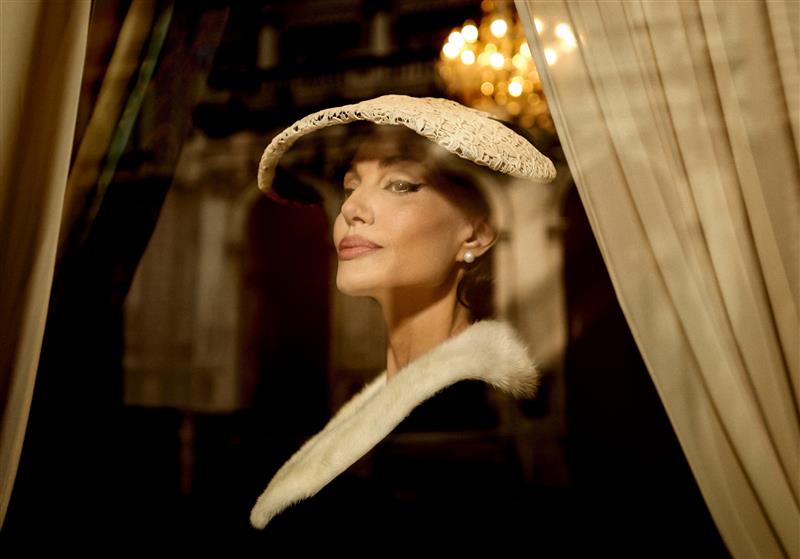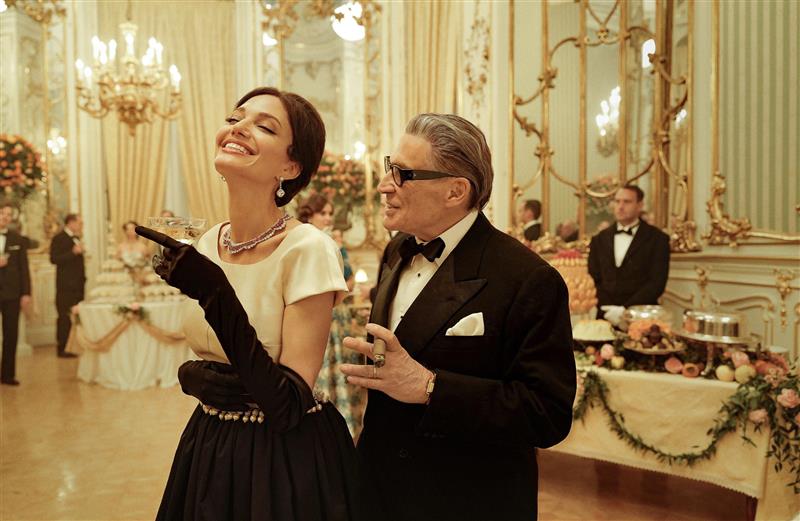Angelina Jolie transforms into Maria Callas for new biopic
Angelina Jolie’s transformation into the late opera singer, Maria Callas, is remarkable – but who is the woman beneath the iconic costumes?
Words by Nikki Peach

Ever wondered what Angelina Jolie would look like as a 20th century Greek Opera singer? Frankly, neither did we, until we saw the new stills from her Oscar-tipped biopic Maria. And yes, she looks incredible.
Jolie has transformed into the global soprano phenomenon, Maria Callas, in both beauty and stature. Draped in custom costumes, luxe wool coats and exquisitely tailored gowns, Maria spells a marked shift from the sword-holstering gold armour Jolie wore in her last film, Eternals.
With a face as distinctive as Jolie’s, it’s the styling that does the talking in this project. While it does not seem like the art team deployed the use of prosthetics – which were used to transform Sofia Vergara into the Columbian drug-lord Griselda Blanco in the Netflix drama Griselda out earlier this year – Jolie still bears a striking resemblance to the opera star. She even underwent seven months’ worth of singing lessons and learned how to breathe in an entirely new way and has subsequently been described as a ‘magical match’ by Deadline.

Who is the real Maria Callas?
Whenever a biopic comes out, audiences are of course left wanting to know more about the subject – especially when said subject is a woman that history may have otherwise forgotten. Maria arrived in US cinemas on 27 November and comes to UK cinemas on 10 January and will then be available to stream on Netflix.
In the psychological drama – directed by Pablo Larraín – Jolie plays Greek American opera singer, Maria Callas, who is widely considered to be one of the most renowned and influential sopranos of the 20th century.
It is the third and final film in Larraín’s trilogy of important 20th century women, succeeding Jackie (2016) and Spencer (2021). Jolie has been tipped to win her second Academy Award for her performance, having first won in 2000 for her supporting role in Girl, interrupted. She has also won praise for her astonishing on set looks from the film, with one fan writing ‘my jaw drops every single time, she is unreal’ on X.
Callas, born Maria Kalogeropoulos, was born in New York in 1923 to Greek immigrant parents. Lore suggests that her mother Litsa so longed for a son that when Callas, her third child, was born she refused to look at her for four days.
Her parents reportedly had an unstable relationship and in 1937, Litsa, Callas and her sister Yakinthi moved to Athens. It was in Greece where Callas received her musical education and started to gain a reputation for her talents. She made her professional debut in February 1941 in a small part in Franz von Suppé’s, Boccaccio. By 1942, she landed her first leading role as Marta in Eugen d’Albert’s, Tiefland.
Living in Athens Callas and her family were forced to contend with wartime poverty and her relationship with her mother continued to suffer. It was one that plagued her adult life, with Litsa going on to write a book about her called, My Daughter Maria Callas, which was published in 1960. They later became estranged.
By the time Callas left Greece in 1945, she had given 56 performances in seven operas and had appeared in 20 recitals. She then returned to the states and was reunited with her father but rejected several offers to perform.
In 1947, she moved to Italy to perform in an opera in Verona. It was here where she met her first husband, Giovanni Battista Meneghini, who she married in 1949. He assumed control of her career until 1959, when Callas had an affair with and then married the Greek shipping tycoon, Aristotle Onassis.
Her career was peppered with various scandals, an ongoing rivalry with the Italian soprano Renata Tebaldi and relentless media interest in her personal life – including her relationship with her mother, her affair with Onassis and her deteriorating health.
According to one of her biographers, Nicholas Gage, Callas and Onassis had a son who died hours after he was born in 1960. Her first husband, however, wrote a book about his wife and said she was unable to bear children.
Callas and Onassis’ relationship ended in 1968 when he reportedly left her for Jacqueline Kennedy – the subject of the first film in Larraín’s trilogy. However, it’s thought that Callas and Onassis continued their relationship while he was with Kennedy.

How was Maria treated by the media?
Callas was accused of temperamental behaviour throughout her career, earning her the title of the ‘greatest diva’.
She has posthumously been described as ‘lonely, unhappy and often difficult’, to which her friend the music critic John Ardoin replied, ‘There are times when there are people – certain people who are blessed, and cursed, with an extraordinary gift, in which the gift is almost greater than the human being. And Callas was one of those people.
‘It was almost as if her wishes, her life, her own happiness were all subservient to this incredible, incredible gift that she was given, this gift that reached out and taught us all – taught us things about music we knew very well, but showed us new things, things we never thought about, new possibilities.’
In fact, many people have suggested that Callas’ relationship with Onassis offered her a much-needed escape from her celebrity – something she found increasingly difficult as the years went on.
Unsurprisingly, the scrutiny extended to Callas’ appearance. In the early stage of her career, she described herself as ‘heavy’ and said her ‘vocalising was getting heavy’ as a result. Between 1953 and 1954, Callas lost almost 80 pounds (36kg) and was suddenly described as ‘the most beautiful lady on the stage’. Rumours about her weight loss tactics swiftly followed, with suggestions ranging from tapeworm to one pasta company which claimed she had been eating their food as a diet. The latter of which prompted Callas to file a lawsuit.
Regardless of how she was mistreated, it is Callas’ vocal range that she is best remembered for. According to the BBC’s profile on the singer, she managed ‘to unite high culture and pop culture, without compromising her repertoire’. As such, she was celebrated in world class institutions and even enjoyed success singing on prime-time TV.
To many, Callas was an archetypal diva in the greatest sense. No male divo from that era ever managed to reach the same heights.
As for her depiction in Maria, it would be impossible to create a film about her life without music. Jolie reportedly spent seven months training her voice for the role and the vocals heard in the film are a blend of Jolie’s and real recordings of Callas.
The film, which was internationally co-produced between Italy, Germany and the US, is set in Paris in the 1970s. Callas spent her final years living in isolation and died of a heart attack in 1977 at the age of 53. Maria received an eight-minute standing ovation at the Sala Grande Theatre during its world premiere, reducing Jolie to tears.
Photo: Studio Canal
